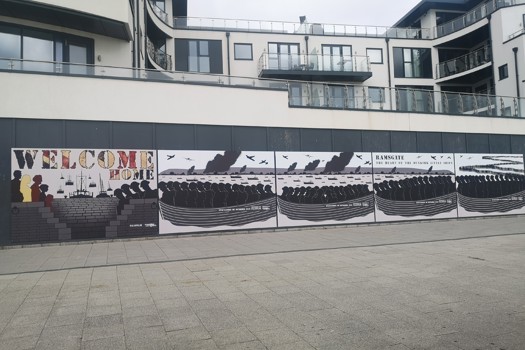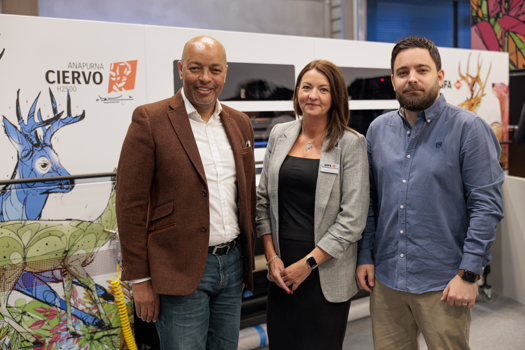Such a move can widen your product range and broaden the skills mix of your team, he says. It can expand market share, rack up revenues and nudge you into a wider geographic sphere. But successfully integrating a new business, according Greene, is as much art as science, relying on deft interpersonal skills and the powers of persuasion as well as business, accounting and legal acumen.
The challenge
Two years ago his predominantly litho company based in Tottenham Hale, north London, bought the digital house Abacus Print a few miles south in Clerkenwell. This was familiar, almost well-trodden territory, for Greene and finance director Bill Kelly. Around 2005 their company brought Lithoflow into the Witherbys fold and before that there were two other takeovers.
Witherbys goes back even further, tracing its origins to the dark alleyways of Georgian London where, among the wigmakers, milliners and coffee shops of the City, stationer Thomas Witherby set up shop, quill in hand to ink legal documents. Expansion, along with calligraphy, was a strong card and has been ever since, with acquisition a shrewd means to an end of ever-expanding potential for Witherbys.
“As a traditional litho company we were looking at moving into digital, so acquiring a company would help us into that market,” explains Greene. “Our client base was interested in us doing more digital work, all of which we were subcontracting. Abacus, which did some litho work, seemed a good complement: we could bring over staff and kit for a win-win outcome.”
Up to that point Abacus, a 45-year-old company, was producing short-run and personalised print for clients including advertising agencies – just the kind of work Witherbys wanted to grab. The 15-staff business had a £1.2m turnover but “wasn’t doing particularly well”, recalls Greene. The owner, Sheikh Raziuddin Raja, was looking to retire and sell the building to release a lump sum.
Greene and Kelly, whose company at the time had 29 staff and a £2.8m turnover, made their move. They approached Raja and using their own money bought the goodwill and assets, including Xerox 770 and 8080 presses. The deal, for an undisclosed sum, was structured to include a percentage of the turnover for three years. Five staff and the two Xeroxes moved from Clerkenwell to Tottenham.
The method
As well as legal advice from solicitors, Greene and Kelly were helped by the BPIF, which gave “lots of positive support”, says Greene. But many of the judgement calls were down to the directors’ own entrepreneurial instinct: “We’ve done this before and therefore have experience in acquisition. It is something of a model we have created and adapted and, touch wood, it is very successful.”
Success is not a given, he insists, with a nod to Royal Bank of Scotland’s damaging acquisition of Dutch rival ABN Amro in 2007, billed by some as the worst ever merger-and-acquisition deal. Even the largest companies with top merger experts can fail at executing acquisitions, which don’t always live up to their hype of delivering strategic benefits and easy growth.
And it can be just as difficult, sometimes more so, for smaller companies that have more riding on staying focused, says Greene.
Integrating an acquisition is complicated and to stay the course, attention to detail is a must. Witherbys’ purchase was fairly complicated because it involved technology, product and the integration of business processes, he says.
“One of the most important indications on whether the acquisition and subsequent integration of a business will work is when you meet the owner – do you get on well; is there mutual trust? Both parties must want to do the deal and that applies at all levels of both businesses, not just in the respective boardrooms.”
Beyond the boardroom, two crucial parties are vital to the success or otherwise of integrating the newly acquired business: staff and customers. Staff need reassurance on job security, pay and conditions; customers need to know service levels and quality of work will not be hit by the takeover. The key is balancing open communication with discretion.
“At this stage you have to be very focused on staff and customers. Before the deal has been signed there has to be a little discretion because nothing is certain, but after that point you need to talk to staff as much as possible and send clear reassurance to clients. Staff will be dealing with new customers and colleagues and they need to pull together. Regular communication is the way to make that happen, collectively and, if necessary, one-to-one.”
The result
Of course it helped that the five Abacus staff – many of the other employees were part time or nearing retirement and did not come over to Witherbys – were joining a slightly bigger company with better conditions and pay, so this deal was not too hard a sell, says Greene.
“It comes down to securing your future in an industry without a vast pool of jobs out there and, to be fair, Witherbys has a very, very small turnover of staff; people see the benefits of a long-term future with our company. The five employees who came over to us in 2013 are still here. In some cases, deals fail not because they are the wrong deal. The point of failure can be the integration; the way cultural differences are handled during the integration can mean they just can’t work together.”
As with Lithoflow, Abacus was co-branded as Witherbys Abacus over a period of time, but the eventual aim is to bring both acquisitions together under the one, all-embracing Witherbys’ brand. The acquisition, reports Greene, has been very successful. In the two years since the takeover, Witherbys has added nearly £1m to its turnover and further expansion is still in the offing.
“We are hoping to make the digital side of our business bigger in the next few years and are looking at more investment within 18 months or so. We are also looking at expanding our finishing with the purchase of another folder, meanwhile our litho work remains very buoyant.”
All this, admit Greene and Kelly, is a far cry from the wigmakers, hosiers and hatters of 1740s London, where Thomas Witherby made his mark at the intersection of Exchange Alley and Birchin Lane and right next door to the Sword Blade coffee house. But the entrepreneurial drive and the thrill of business expansion have changed not one jot of the penman’s quill.
“Ideally we will keep growing, but within sensible limits,” says Greene. “We are not looking to double turnover but would like to see steady growth and an expanded digital side of our business.
If the chance of another acquisition came up and the company complemented what we already have, we would almost certainly take that opportunity, be it digital or litho or a mixture of the two.”
VITAL STATISTICS
Witherbys
Location Tottenham Hale, north London
Inspection host Managing director James Greene
Size Turnover: £3.7m; Staff: 35
Established 1740
Products Annual reports, brochures, booklets, leaflets, newsletters and datasheets, magazines, catalogues, periodicals, letterheads, compliment slips, business cards, direct mail and envelopes
Kit Litho: six-colour Heidelberg Speedmaster SX 74 perfector, five-colour Speedmaster 74 with dryer, two-colour GTO 52, one-colour GTO 52. Digital: Xerox DocuColor 8080, Xerox DocuColor 7070, Epson Stylus Pro 7900 and 7000 colour proofers, two Xerox DocuPrint laser printers
Inspection focus Integrating an acquired business
TOP TIPS
Keep good company Make sure your takeover target is the right company, ensuring its size, products and skills mix complement your business.
Plan ahead Develop a clear but flexible plan for the integration; define your top goals and set expectations of what you want to achieve over a given timeframe.
It’s good to talk Most people fear change and will be asking ‘how will this acquisition affect me?’ So keep them in the loop with regular updates and address their concerns early.
Keep focused Avoid wasting energy on areas that don’t deliver value in the first three months, such as quibbles over how to submit expenses forms, stay focused on the core business.
Don’t be too ambitious You don’t want to take on more than you can afford, far better to take it “slow and steady”, cautions Witherbys’ managing director James Greene.
Don’t borrow too heavily Because if the acquisition does go wrong you could put your own business in jeopardy.
Keep persevering Explain to your team that it’s normal to have doubts and frustrations, but remind them why the acquisition was made, what the end goal is and why it will be beneficial.










